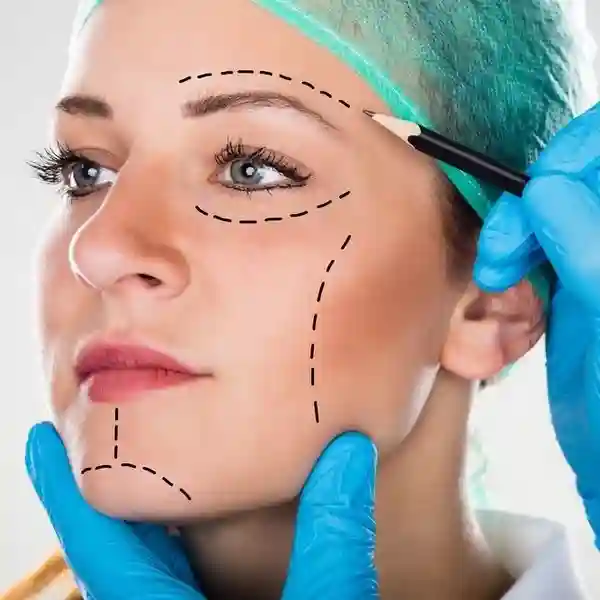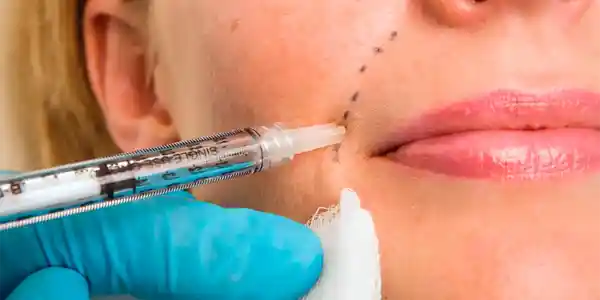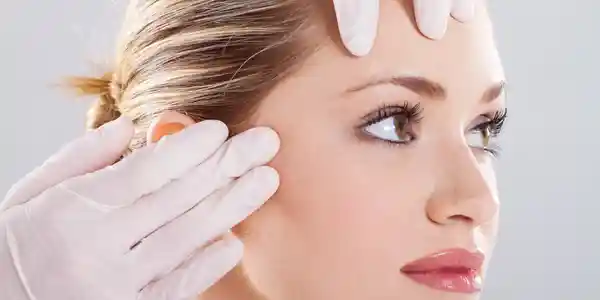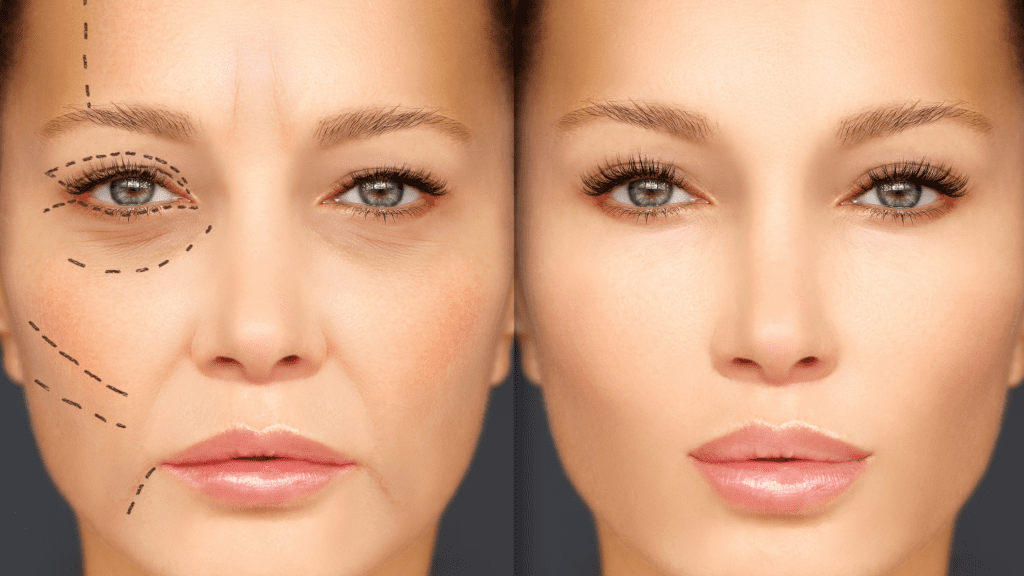Introduction:
Blepharoplasty, or surgery to remove extra skin, fat, and loose muscles from the upper and lower eyelids, is a cosmetic technique used to rejuvenate the appearance of the eyes. This article explores the benefits and considerations of surgery on the upper and lower eyelids, as well as their history, general procedure, and various procedures.

History of Eyelid surgery

Ancient Origins:
Throughout ancient civilizations, there has always been a desire to enhance the appearance of the eyes. It is known that the ancient Egyptians employed kohl to darken their lashes and eyelids; some cultures still utilize this cosmetic technique today.
The oldest known surgical interventions on the eyelids date back to approximately 800 BC and were carried out in India. Rather from being performed for esthetic purposes, the primary goals of these early procedures were to repair abnormalities of the eyelids and restore vision.
During the 1800s, European surgeons initiated the process of creating methods for doing cosmetic eyelid surgery. These methods were developed during World War I to treat soldiers with facial injuries, and they are credited to the New Zealand plastic surgeon Sir Harold Gillies.

Modern Blepharoplasty:
Surgeons began honing their procedures for both upper and lower eyelids in the mid-1900s, ushering in the modern era of blepharoplasty. With the advent of more accurate surgical instruments and techniques, eyelid surgery made great progress in the 1960s and 1970s.
Technological Advancements:
Blepharoplasty methods have developed throughout time. Modern surgeons can perform quicker recovery periods and more accurate incisions thanks to the availability of sophisticated instruments like lasers. Additionally, methods for treating certain issues including drooping eyelids, extra skin, and under-eye bags have been created.
Popularity and Accessibility:
Millions of people have blepharoplasty surgery annually to revitalize their appearance, making it one of the most popular cosmetic treatments in the world. Technological and medical advances have improved the procedure’s safety and accessibility for a larger group of patients.
Procedure in General:
Anesthetic:
Depending on the scope of the procedure and the patient’s and surgeon’s preferences, the surgery is typically conducted under general anesthetic or local anesthesia with sedation.
The incision for upper eyelid surgery is usually done in the natural crease of the eyelid, which facilitates the removal or realignment of extra skin and fat. In lower eyelid surgery, the incision is done either inside the lower eyelid (transconjunctival incision) or immediately below the lower lash line, depending on the particular problems that need to be treated.
Tissue Adjustment:
To enhance the shape and appearance of the eyelids, the surgeon will make incisions and then remove or relocate extra skin, muscle, and fat. This could entail raising drooping eyelids, tightening loose skin, and eliminating fat pads that result in under-eye bags.
Closure:
Surgical tape or sutures are used to seal the incisions after any necessary corrections have been made. To reduce obvious scarring, the surgeon will take care to position the incisions in folds found in nature or along the lash line.
Recovery:
Patients are often kept under observation in a recovery room until they are completely conscious and prepared to return home following the treatment. In the days after surgery, some swelling, bruising, and soreness are normal, but these side effects usually go away after a while.
Follow-Up:
Following surgery, patients usually schedule a follow-up consultation with their surgeon to assess how they are recuperating and make sure everything is going according to plan. The surgeon might offer extra guidance on aftercare and recuperation.

Various techniques
Upper Eyelid Blepharoplasty:
This procedure targets the overabundance of fat, muscle, and skin on the upper eyelids. Usually, the incisions are performed along the natural crease of the eyelid, which gives the surgeon the opportunity to remove or rearrange tissue to give the appearance of greater vitality and freshness.
Lower Eyelid Blepharoplasty:
Using this method, extra fat pads are accessible and removed without leaving any noticeable external scars by making a trans conjunctival Incision on the interior of the lower eyelid. Patients with small skin laxity or localized fat bulges can benefit from this technique.
For individuals with minor skin laxity, the transconjunctival technique is the best option since it includes making an incision inside the lower eyelid to access and remove fat without the need for exterior incisions.
Canthoplasty:
To tighten the lower eyelid and correct its position, canthoplasty is frequently combined with eyelid surgery. To get a more visually acceptable effect, it entails moving or strengthening the canthus, which is the outer corner of the eyelid.
When a patient of Asian heritage wants a crease in their top eyelid, Asian eyelid surgery, also known as double eyelid surgery, is frequently used. Enhancing the appearance of the eyes is achieved by the creation of a natural-looking eyelid crease.
Ptosis Repair:
Drooping of the top eyelid is a symptom of ptosis, a disorder that can impair both appearance and vision. Lifting the eyelid to a more normal position requires ptosis correction, which entails strengthening the muscles controlling eyelid movement.
Although a brow lift is not a substitute for eyelid surgery, it can be used in conjunction with it to treat forehead creases and drooping brows. For a more youthful appearance, the brows can be lifted and repositioned with this surgery, which can be done using a variety of procedures, such as endoscopic brow lift and coronal brow lift.
Combination operations:
To accomplish total facial rejuvenation and address many cosmetic issues at once, eyelid surgery may occasionally be coupled with other facial rejuvenation operations like a facelift or laser skin resurfacing.
Benefits, Comparisons, and Considerations:
Surgery on the Upper Eyelid:
consists of trimming or realigning extra skin, muscle, and fat from the upper eyelids.
Benefits include treating drooping eyelids, reducing visual blockage, and giving the look of young.
Take into account: Might not treat problems like dark circles or under-eye bags, but can make eyes appear more rested or older.
Surgery on the lower eyelid:
Treats bags under the eyes, puffiness, and extra skin in the lower eyelids.
Benefits: Restores the eyes’ appearance of youth and rest.
Take into account: In comparison to upper eyelid surgery, there can be a lengthier recovery period.
Blepharoplasty through the trans conjunctiva:
The process entails creating a cut inside the lower eyelid in order to eliminate or realign fat deposits.
Advantages: Minimally invasive; leaves no outward scars.
Patients with isolated fat deposits and limited skin laxity are the best candidates, according to considerations.
Asian Blepharoplasty, A procedure that removes both eyelids:
For individuals of Asian heritage who do not normally have a crease in their upper eyelid, this procedure creates one.
Advantages: Can improve eyelid symmetry and eyesight look.
The anatomy of each eyelid and the desired aesthetic result must be carefully taken into account.
Comparing canthoplasty vs canthopexy
Procedures to adjust and tighten the canthus, or outside corner, of the eyelids will be described.
Benefits: Enhances the contour and tone of the eyelids and improves the eyes’ overall look.
Taking into account: For best outcomes, this procedure can be combined with other eyelid procedures.

Brow Lift (Forehead Lift):
Appearance:
A more young and revitalized appearance can be achieved by having brow lift surgery, which can renew the forehead and brows.
Reduce Wrinkles:
Brow lift surgery helps lessen the appearance of wrinkles and lines on the forehead and in between the eyebrows by elevating and tightening the skin.
Taking into account
Scarring:
After brow lift surgery, there is a chance of visible scarring, despite efforts to position incisions in discrete places.
Recovery: Every patient’s recuperation is unique, so it’s critical to carefully follow your surgeon’s post-operative recommendations to promote the best possible healing.
Complications and risks:
Risks: Bleeding, infection, and anesthesia-related side effects are among the hazards that come with brow lift surgery, just like with any surgical operation. Selecting a board-certified plastic surgeon with substantial experience doing brow lift surgery helps reduce these risks.
Conclusion:
Blepharoplasty, the procedure to remove the upper and lower eyelids, is a good way to rejuvenate the eyes and provide the appearance of being more youthful and rejuvenated. Patients can make well-informed decisions and attain satisfactory outcomes under the supervision of a qualified and experienced plastic surgeon by being aware of the background, general process, different procedures, and related aspects of eyelid surgery. In order to create a customized treatment plan that meets each patient’s specific needs and intended results, it is imperative to talk about individual goals, concerns, and expectations throughout the consultation phase.
- All Posts
- Uncategorized

Dr. Daniel Davidson, MD, MBA Introduction: The goal of success for businesses nowadays is to establish a global brand because…

Dr. Daniel Davidson, MD, MBA Introduction: Stem cells have captivated the imagination of scientists and the public alike for their…

Dr. Daniel Davidson, MD, MBA Introduction: Platelet-rich plasma (PRP), fat grafting, and dermal fillers made from natural sources are examples…
